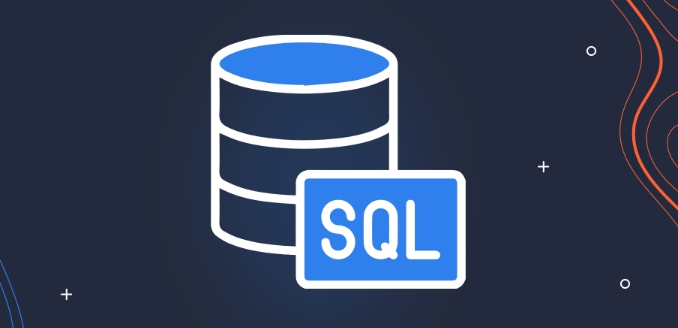Interpreting SQL Query Execution Plans for Performance Analysis.
Jul 15, 2025 am 02:51 AMTo understand SQL execution plan, first use the database's own commands (such as MySQL's EXPLAIN, PostgreSQL's EXPLAIN ANALYZE, and SQL Server graphical interface) to obtain the execution plan; secondly, focus on checking the scan type, whether temporary sorting or temporary tables occur, estimated row count and cost values; then focus on common performance bottlenecks such as full table scanning, low nesting loop efficiency, temporary sorting, etc.; finally, adjusting based on actual conditions, including checking indexes, avoiding SELECT *, optimizing JOIN and sorting operations, and regularly updating statistical information.

Understanding SQL query execution plans is a key step in optimizing database performance. Many people’s first reaction when seeing an execution plan is that they “can’t understand it”. In fact, as long as they master a few core indicators and analysis methods, they can quickly locate the problem.

Basic ways to view execution plans
The commands for viewing execution plans in different database systems are slightly different. For example, use EXPLAIN in MySQL, EXPLAIN ANALYZE in PostgreSQL, and use graphic interface to directly display the execution plan in SQL Server.

Generally speaking, the execution plan will show information such as the type of operation, access method, the amount of data involved, and the estimated cost of each step. The key point is:
- Which type of scan was used (full table scan or index scan)
- Whether a temporary sort or temporary table appears
- Is the estimated number of rows reasonable?
- Is there a step toward a cost value (cost) significantly higher?
This information can help you determine whether there are inefficient operations in the current query.

Pay attention to common performance bottlenecks
Several of the most noteworthy performance bottlenecks in the execution plan include:
- Full table scan : If a table does not go through the index but performs a full table scan, it may mean that the appropriate index is missing or the query conditions are unclear.
- Temporary sort/temporary table : This usually occurs when there is
ORDER BY,GROUP BYor a subquery. If the data volume is large, such operations will significantly affect performance. - Inefficient nested loops : When joining two large tables, the cost of nested loops may be very high. You can consider rewriting SQL or adjusting the connection method.
- High-cost node : The "cost" field in the execution plan can help you identify which step is the most resource-consuming, and priority optimization of this part is often the most obvious effect.
For example, if you find that a query scans a table of millions of data in a full table, but actually only requires a few thousand records, it is likely that the index is missing or the index is not used correctly.
How to optimize based on actual conditions
After getting the execution plan, the next step is to tune according to the observed problems. Here are a few practical suggestions:
- Check if fields in WHERE conditions have appropriate index support
- Try to avoid SELECT *, select only the required fields, and reduce the amount of data transmission
- For JOIN operation, confirm whether the connection field has been indexed
- If file sorting occurs, you can try to avoid it by adding overwrite indexes or adjusting ORDER BY
- Use forced indexes (such as FORCE INDEX) appropriately to verify the index effect
It should be noted that sometimes the "optimal path" given by the execution plan is not necessarily really optimal, especially when the statistical information is inaccurate. Therefore, it is also important to update statistics regularly.
Basically that's it. Understanding the implementation plan is not something that can be achieved overnight, but as long as you look at a few more real cases, you can quickly establish basic judgment skills.
The above is the detailed content of Interpreting SQL Query Execution Plans for Performance Analysis.. For more information, please follow other related articles on the PHP Chinese website!

Hot AI Tools

Undress AI Tool
Undress images for free

Undresser.AI Undress
AI-powered app for creating realistic nude photos

AI Clothes Remover
Online AI tool for removing clothes from photos.

Clothoff.io
AI clothes remover

Video Face Swap
Swap faces in any video effortlessly with our completely free AI face swap tool!

Hot Article

Hot Tools

Notepad++7.3.1
Easy-to-use and free code editor

SublimeText3 Chinese version
Chinese version, very easy to use

Zend Studio 13.0.1
Powerful PHP integrated development environment

Dreamweaver CS6
Visual web development tools

SublimeText3 Mac version
God-level code editing software (SublimeText3)
 How to find columns with a specific name in a SQL database?
Jul 07, 2025 am 02:08 AM
How to find columns with a specific name in a SQL database?
Jul 07, 2025 am 02:08 AM
To find columns with specific names in SQL databases, it can be achieved through system information schema or the database comes with its own metadata table. 1. Use INFORMATION_SCHEMA.COLUMNS query is suitable for most SQL databases, such as MySQL, PostgreSQL and SQLServer, and matches through SELECTTABLE_NAME, COLUMN_NAME and combined with WHERECOLUMN_NAMELIKE or =; 2. Specific databases can query system tables or views, such as SQLServer uses sys.columns to combine sys.tables for JOIN query, PostgreSQL can be used through inf
 Comparing Different SQL Dialects (e.g., MySQL, PostgreSQL, SQL Server)
Jul 07, 2025 am 02:02 AM
Comparing Different SQL Dialects (e.g., MySQL, PostgreSQL, SQL Server)
Jul 07, 2025 am 02:02 AM
SQLdialectsdifferinsyntaxandfunctionality.1.StringconcatenationusesCONCAT()inMySQL,||orCONCAT()inPostgreSQL,and inSQLServer.2.NULLhandlingemploysIFNULL()inMySQL,ISNULL()inSQLServer,andCOALESCE()commonacrossall.3.Datefunctionsvary:NOW(),DATE_FORMAT()i
 What is the difference between SQL and NoSQL
Jul 08, 2025 am 01:52 AM
What is the difference between SQL and NoSQL
Jul 08, 2025 am 01:52 AM
The core difference between SQL and NoSQL databases is data structure, scaling method and consistency model. 1. In terms of data structure, SQL uses predefined patterns to store structured data, while NoSQL supports flexible formats such as documents, key values, column families and graphs to process unstructured data; 2. In terms of scalability, SQL usually relies on stronger hardware on vertical expansion, while NoSQL realizes distributed expansion through horizontal expansion; 3. In terms of consistency, SQL follows ACID to ensure strong consistency and is suitable for financial systems, while NoSQL mostly uses BASE models to emphasize availability and final consistency; 4. In terms of query language, SQL provides standardized and powerful query capabilities, while NoSQL query languages ??are diverse but not as mature and unified as SQL.
 Advantages of Using Common Table Expressions (CTEs) in SQL.
Jul 07, 2025 am 01:46 AM
Advantages of Using Common Table Expressions (CTEs) in SQL.
Jul 07, 2025 am 01:46 AM
The main advantages of CTEs in SQL queries include improving readability, supporting recursive queries, avoiding duplicate subqueries, and enhancing modular and debugging capabilities. 1. Improve readability: By splitting complex queries into multiple independent logical blocks, the structure is clearer; 2. Support recursive queries: The logic is simpler when processing hierarchical data, suitable for deep traversal; 3. Avoid duplicate subqueries: define multiple references at a time, reduce redundancy and improve efficiency; 4. Better modularization and debugging capabilities: Each CTE block can be run and verified separately, making it easier to troubleshoot problems.
 When to use SQL subqueries versus joins for data retrieval.
Jul 14, 2025 am 02:29 AM
When to use SQL subqueries versus joins for data retrieval.
Jul 14, 2025 am 02:29 AM
Whether to use subqueries or connections depends on the specific scenario. 1. When it is necessary to filter data in advance, subqueries are more effective, such as finding today's order customers; 2. When merging large-scale data sets, the connection efficiency is higher, such as obtaining customers and their recent orders; 3. When writing highly readable logic, the subqueries structure is clearer, such as finding hot-selling products; 4. When performing updates or deleting operations that depend on related data, subqueries are the preferred solution, such as deleting users that have not been logged in for a long time.
 What is a composite primary key in SQL?
Jul 08, 2025 am 01:38 AM
What is a composite primary key in SQL?
Jul 08, 2025 am 01:38 AM
AcompositeprimarykeyinSQLisaprimarykeycomposedoftwoormorecolumnsthattogetheruniquelyidentifyeachrow.1.Itisusedwhennosinglecolumncanensurerowuniqueness,suchasinastudent-courseenrollmenttablewherebothStudentIDandCourseIDarerequiredtoformauniquecombinat
 How to find the second highest salary in SQL
Jul 14, 2025 am 02:06 AM
How to find the second highest salary in SQL
Jul 14, 2025 am 02:06 AM
There are three core methods to find the second highest salary: 1. Use LIMIT and OFFSET to skip the maximum salary and get the maximum, which is suitable for small systems; 2. Exclude the maximum value through subqueries and then find MAX, which is highly compatible and suitable for complex queries; 3. Use DENSE_RANK or ROW_NUMBER window function to process parallel rankings, which is highly scalable. In addition, it is necessary to combine IFNULL or COALESCE to deal with the absence of a second-highest salary.
 How to create empty tables with the same structure as another table?
Jul 11, 2025 am 01:51 AM
How to create empty tables with the same structure as another table?
Jul 11, 2025 am 01:51 AM
You can use SQL's CREATETABLE statement and SELECT clause to create a table with the same structure as another table. The specific steps are as follows: 1. Create an empty table using CREATETABLEnew_tableASSELECT*FROMexisting_tableWHERE1=0;. 2. Manually add indexes, foreign keys, triggers, etc. when necessary to ensure that the new table is intact and consistent with the original table structure.






